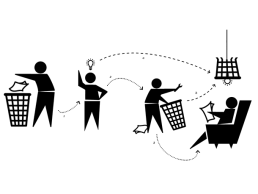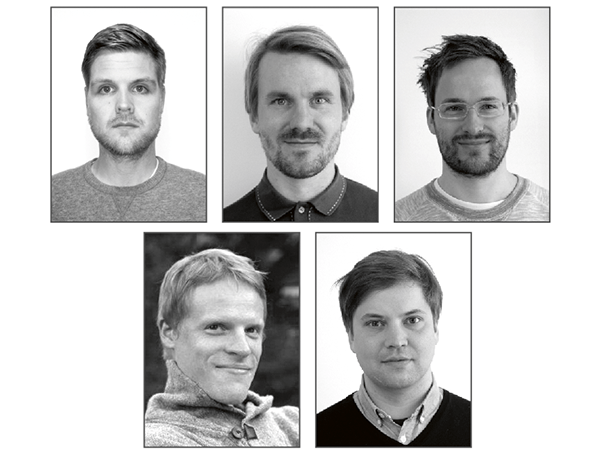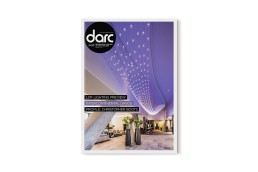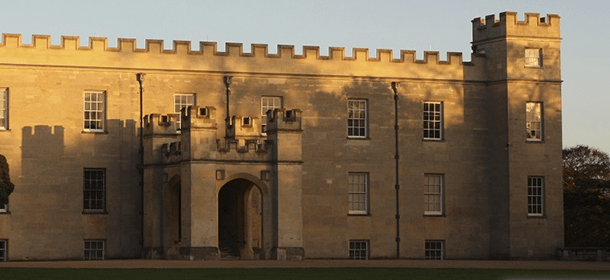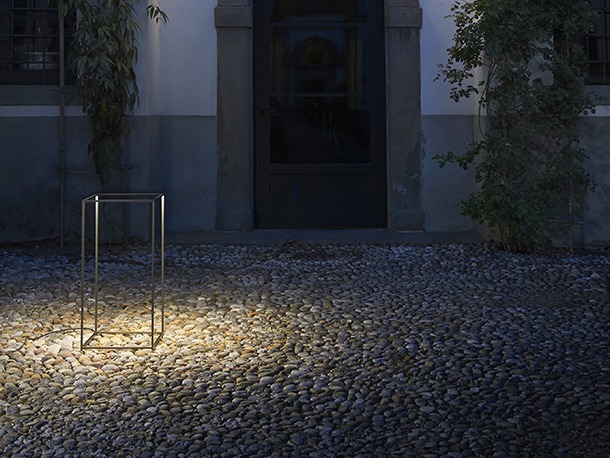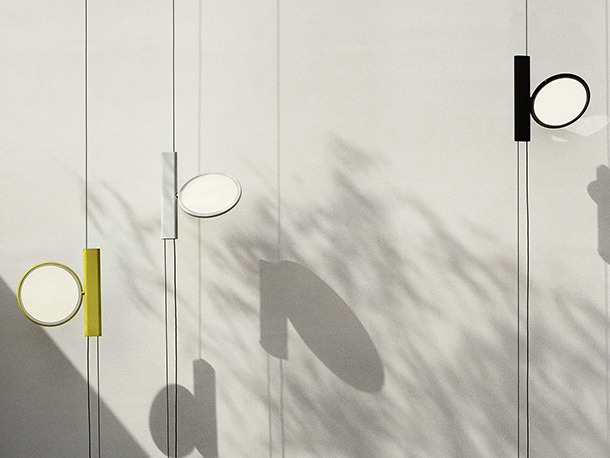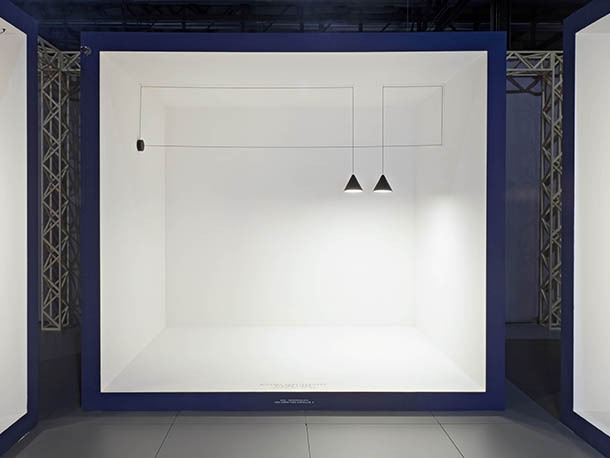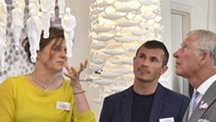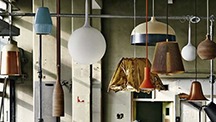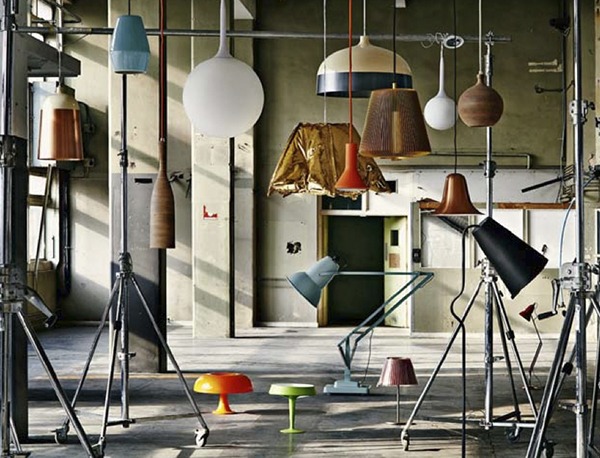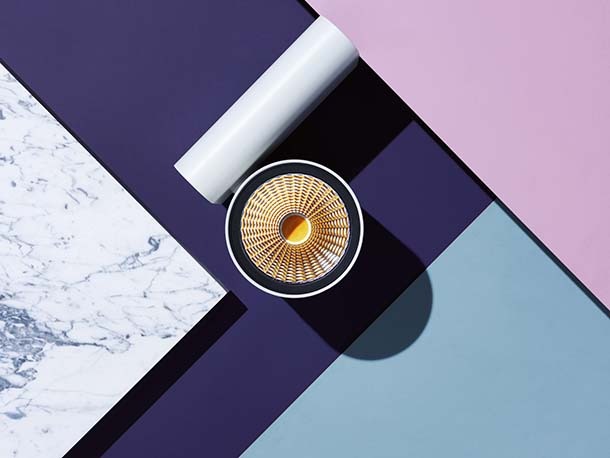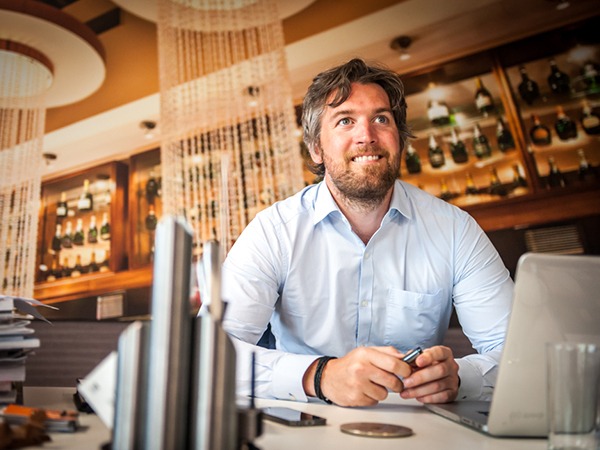Creative Cycles
Recycled, refurbished, reimagined or repurposed, upcycling elements to create decorative lighting pieces can be a great way of introducing a unique, personalised aesthetic to an interior, as Jennifer Hamilton explains.
The one thing I aim to create in all my schemes is a sense of individuality – something to which each specific client can relate and which reflects their own personality and lifestyle.
What better way to achieve this than through the use of distinctive, one-off pieces, selected or designed with the client themselves, which gives them something they will always love and know is unique to them.
Sometimes, this takes the form of vintage pieces or antiques, sometimes artwork, and sometimes by repurposing an item that has always been in the family and giving it a new lease of life. You can even create something bespoke by putting together junk shop finds or everyday items and using them in a different way.
Lighting is a great way to do this. I believe lighting should be interesting, and varied, and we use a lot of lamps and wall lights, particularly in residential schemes to retain a relaxed feel – and to contrast with the more architectural elements of the design.
Not wanting to reuse the same thing everywhere and aiming to suit the client’s tastes and budget, while ensuring an element of individuality – means I am always on the hunt for new and creative lighting solutions.
On one recent project we created a lamp using an owl statue, which originally belonged to the client’s grandmother. We made up a new shade with a Cole & Son lining to bring it bang up-to-date.
If you do not have eccentric relatives with lofts to raid, try Alex Randall (www.alexrandall.co.uk) who has some amazing taxidermy pieces. From squirrel wall lights to pigeon chandeliers, these are emotive and exciting, and beautifully made. They also provide a fantastic talking point – and are more a piece of art than a light fitting.
Of course taxidermy isn’t for everyone and you don’t need to go to that extreme. In my house I have a lamp which my father made from an old 1920s telephone. Over the years it has had many different looks with garish 70s shades – but I think it’s far from kitsch now.
On a current project we are using a chrome chandelier, which was in the client’s master bedroom. By sending it off to be powder coated in a bright colour, we have created an entirely new feature for the refurbished double-height kitchen with vaulted ceiling.
For another recent project we trawled eBay and junk shops hunting for the perfect ‘plafonier’ lighting fitting – it is often very hard to find something vintage which a client has in their head as, of course, you are limited to the options for sale at the time. Finally, the potentially perfect fitting was tracked down to a junk shop in Chichester, and the client spent a sunny Sunday heading off to have a look, and proudly returned with it in the boot of his car. It was mucky and had several bits missing but following a rewire, clean up and repair it now looks stunning as the centerpiece of a stairwell; and the client has a great memory of seeking it out.
The current obsession with ‘vintage’ means it is getting easier to source fittings which someone has already lovingly gathered and restored – be they East German factory lights, crystal chandeliers or French barn lights, there are a great range of sources out there. Try: Retrouvius (www.retrouvius.com); Skinflint (www.skinflintdesign.co.uk); Trainspotters (www.trainspotters.co.uk); Elemental (www.elemental.uk.com); Marmorea (www.marmorealondon.com) and The French House (www.thefrenchhouse.co.uk).
The same eclectic approach to lighting can be used in commercial spaces to add a softer feel. At the SAS office in Central London, part of MSL Group, lighting played a key role in zoning areas and creating different atmospheres to break up the space. ‘Key Klamp’ scaffold structures combined with woven ‘walls’ of natural twine, divide the floors. From these screens ‘vintage’ lighting is hung - some junk shop finds and some new, but with a reclaimed or industrial feel.
There are now lots of great places selling different flex and lamp holders in different finishes - Urban Cottage (www.urbancottageindustries.com) and Dyke & Dean (www.dykeanddean.com), for example.
This makes it easy to create one-off pieces from whatever you have available – rules and regs permitting.
So, all is in place for the designer to use refurbished, vintage or up-cycled pieces in lighting schemes. It is a great way to add something unique to a project and often means you can achieve something special on a budget, and of course, it is a great way to recycle.
Jennifer Hamilton is founder and Creative Director of interior design practice The Vawdrey House.
profile: Christopher Boots
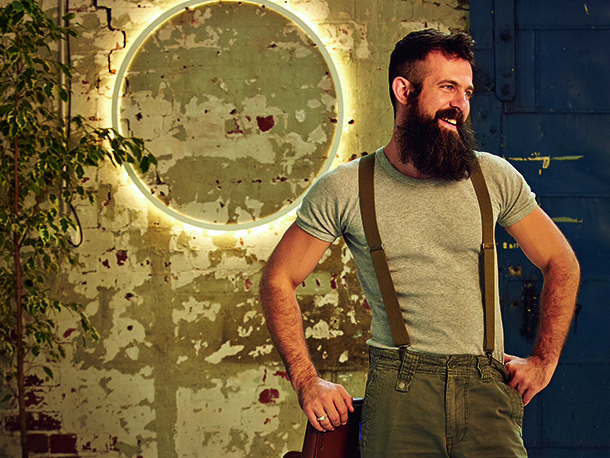
The alchemy of the Earth – the precious stones and metals forged within its rocks – has long held a fascination for designer Christopher Boots. Tucked away on the shelves of his Melbourne studio sits a little book on minerals - a prized possession since the day, age seven, he discovered it in a local thrift store. Its battered pages continue to provide inspiration for his work creating magnificent lighting pieces that themselves seem crafted like giant fine-jewellery from precious elements.
Flora and fauna, geometry and geology, myth and magic, all feed into his collection, a family which includes the burnished branches of Phasmida, the parallelepipedic angles of ORP, the fiery quartz rings of Prometheus and the suspended majesty of Diamond Ring. Each is imbued with its own dramatic narrative, emphasised and elaborated by the dramatic photographic scenes in which they are presented.
“I guess the work itself is detailed and tells various stories depending on the materiality and the process it has gone through in order to become an object,” says Boots. “Why not present this story in a format that tells even more? ‘Diamonds are a girl’s best friend’, hence the presentation of the Diamond RIng with a powerful female to hold the space that it was always intended to create.”
There are hints, too, of the playful approach with which Boots and his studio approach each project.
“It is more a family than a workplace per se,” Boots explains. “We argue, we share meals, we dance. We collaborate with some specialists who are experts and among the best in their respective fields. Coming together is a complex process - how does a community get created? It takes time - a complex process, conscious efforts and a host of other variables that cannot even be contrived. I guess the stars align at the right time and this is what we end up with.”
Boots (nee Boutsinis), studied Industrial Design, specialising in Product Design Engineering from which he graduated in 2005. His first job was working under the legendary Geoffrey Mance in Melbourne, where for two years he learned his craft.
“Geoffrey was always a positive influence. He’d experiment with materials and processes that were quite unexpected and this approach - a playful, experimental take on using items in ways that were novel – was, I guess, a very influential thing to learn from such a mentor,” says Boots. “I learned to not fear - to experiment and be free with ideas. Make mistakes; learn from them; invest in R&D. To this day I never flinch about experimenting with processes and materials. You never know where the journey may end up.”
After Mance’s death in 2007, Boots bought the design studio with a partner – a valuable grounding in running a studio – before breaking away and establishing afresh under his own name in 2011.
Since going solo, Boots’ trajectory continues to rise. In 2013 his ORP pendant was added to the permanent collection of the distinguished National Gallery of Victoria and at the beginning of 2014 his role as lighting judge on The Block, a popular home renovation show on Australia’s Nine Network, made him a household name.
While TV fame may have delivered a huge boost domestically - a profile cannily capitalised upon with the launch of a pop-up, online shop - international recognition also continues to grow steadily. Last year Boots launched his products in high-end design stores in Chicago, Los Angeles and London, with his collection launching in select design stores across South East Asia (including Singapore, Taiwan and Hong Kong) throughout 2014.
“I am so happy with the way things are going,” says Boots. “Creating these pieces is super satisfying, yet I’m aware that I have to pay attention to the business side too. That seems to be flourishing, so it allows me more freedom to create.”
Key among the new collection is the Asterix family. This series of geometric pendants form a sequence of pieces that build in complexity, beginning with the simple Parallelogram and concluding with the Asterix itself. Each comprises sleek, angular brass shapes, inlaid with LED to create glowing and highly decorative sculptural pieces.
“Asterix was designed as a series based on the feeling that came through from Blade Runner, the classical dystopian future film that questions what is it that makes us human,” says Boots. “That future is now and we are living it. I wanted to make a light that spoke to our times.”
The Asterix series expresses these ideas through a minimal, reductive use of lines, creating a piece with an incisive confidence and a sharp beauty.
“Asterix, like the rest of the collection, is designed to be the jewellery of the home. Every home, to truly be complete, needs to be honoured as a space that one comes to dream, to rest and to be in.”
www.christopherboots.com
folio: Futudesign
Though officially founded in 2012, the roots of this five-man practice spans back to a time before Facebook and Twitter, when a collective of Helsinki designers and architects came together on an anonymous internet forum to share anarchic, establishment-challenging ideas on the creative process. The Futudesign forum - a name chosen for its irony-inflected daftness - gradually dried up as its denizens drifted on to newly emerging, mainstream social media, but for five ‘Futu board’ users, the site would prove the springboard for a new studio.
Designer Iikka Airas, architects Auvo Lindroos, Aleksi Niemeläinen and Teemu Seppänen, and interior architect Risto Wikberg, began working together on a series of projects, adopting the Futudesign name from the forum that brought them together. Since then, the young team have applied their skills to a wide range of subjects. “We design cities, buildings, interiors, pop-ups and products,” explains Lindroos. “Basically, everything from door handle to city plan.”
Decorative lighting pieces form an essential part of their interior designs, helping to weave an appropriate atmosphere for each specific space and, if no appropriate fixture can be found, they are willing and able to design one themselves.
ISSUE EIGHT
INSIDE ISSUE #08:
Postcard //
InterContinental Davos • Davos //
New York Palace Hotel • New York //
Harrods • London //
The Trianon • Frankfurt //
Folio: Futudesign //
Profile: Christopher Boots //
Comment: Creative Upcycling //
Upcycled Lighting Gallery //
Calendarc //
London Design Festival Preview //
Profile: Sebastian Bergne //
If...
Decorex relocates to Syon Park
Internationally renowned for being the paramount event to discover the very best in luxury design, Decorex provides a unique platform for launching into the most coveted end of the interior design world. With the focus on increasing number of specialist international exhibitors, this year will see the latest and greatest products thrust into the Decorex limelight, as well as the opportunity to discover stunning installations from the most illustrious designers.
Ipnos
The latest addition to Flos’ already burgeoning outdoor lighting collection is the Ipnos lamp, designed by Rossi & Bianchi. This LED floor lamp can be used both inside and outside and is composed of an ultra-light skeleton of thin extruded aluminum, emanating diffused luminosity.
Ipnos, like much of Rossi & Bianchi’s other products, has a stark minimalist design, with a simple framework of light highlighting a void space, without revealing the light source.
www.flos.com
OK
Konstantin Grcic pays homage to Achille Castiglioni's iconic Parentesi lamp, redesigning the original light bulb as an ultra- flat LED surface with edge-lighting technology, rotating over 360 degrees.
The OK, whose name incorporates the shape of the “O” and the first initial of its German designer, is a story of design evolution from when Flos first launched the Parentesi lamp in 1972.
Once again, Grcic unites technological experimentation with design sensitivity.
"Forty years later, much has changed. The world of lighting has seen a fundamental shift from conventional bulbs to a variety of new lighting technologies which in themselves are creating new opportunities for the design and manufacturing of lamps. Designing a lamp is no longer limited to working around a given bulb. Today, it means designing the actual bulb or light source. This challenged me to think of Parentesi, a lamp that celebrated the traditional bulb in the most effective and beautiful way. Would it be possible to rethink the Parentesi lamp once more and pass the Manzù-Castiglioni torch on to the future?" - Konstantin Grcic
The tube of the original lamp maintains its vertical sliding function over the steel cable, but has now become a small rectangular box that cleverly houses the electronic components and a soft-touch switch. The cylindrical weight hanging at the bottom of Castiglioni's design has been replaced with a conical weight that's easier to install, but the small spun metal ceiling rose remains exactly the same.
String Light
String Lights ceiling lamp comprises a black electric wire that sets up a relationship with the architecture of a space, precisely becoming part of the lines formed by the walls of a room. And stretched out along these lines are two different light sources: one in the shape of an isosceles triangle, the other in the form of a sphere. A system of tensors give volume and three-dimensionality to the form outlined by this lightweight cord that plays with space, while the two LED lamps emit a warm light.
Minimal and poetic like a pencil line drawn in the air, String Lights is an original suspension, both conceptually simple and bold at the same time. Anastassiades has always sought the primordial and original essence of forms and materials. His designs move towards abstraction, in a search for purity that pursues an exercise of stripping away, taking objects and materials back their original dimension of bareness. "My work springs from an idea of subtraction. Because a naked object brought back to its bare essentiality is the ultimate, definitive expression of beauty," says designer Michael Anastassiades.
Of the principles behind String Lights, he explains:
"Every time I take the train, I sit by the window and watch the series of perfectly parallel strings connecting the pylons, as we move at high speed. I love the way they divide the landscape and how spheres are occasionally beaded through the wires at random intervals. I also love how, in Mediterranean cultures, strings of lights are stretched between posts to mark an outdoor space for an evening party in a village square. And finally, I love how human ingenuity works around problems created by everyday things in the house (like switches and power points) that others have chosen to position where we don’t want them."
Scabetti present work for royal visit
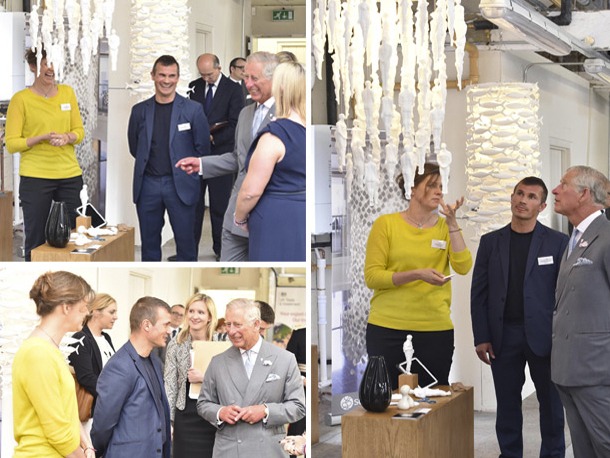
After a major restoration project, supported by the Prince’s Regeneration Trust, Middleport Pottery in Stoke-on-Trent officially opened as a new visitor destination on the 24th June 2014. As part of this event, Frances and Dominic Bromley were invited to present their work to HRH The Prince of Wales. Prince Charles discussed with Dominic and Frances the support that the Prince’s Trust gave Scabetti when it was launched in 1999 and the studio's evolution to the UK launch of their new sculpture, ‘Ascension’.
designjunction with added lightjunction
Organisers have revealed details for the fourth edition of the designjunction show, which returns to the Sorting Office on New Oxford Street for this year’s London Design Festival.
The 2014 edition will see the show expand onto a fourth floor of the former Royal Mail building, enabling more than 180 leading global brands to exhibit. These include some of the best global decorative lighting brands, which will be showing under the lightjunction ‘show-within-a-show’. Organised in partnership with Cameron Peters Fine Lighting, this year lightjunction will encompass the entire basement and parts of the first and second floors. Key lighting brands throughout the show include:
Aircharge, Artemide, Blackbody, Cameron Peters, darc magazine, Design by Mai, Estro, Fontana Arte, Megaman, Nyta, SCE-Orizona, Baroncelli, Brokis, Buster & Punch, Channels, Etano Home, Fontana Arte, Hand&Eye Studio, INDUSTRY+, Innermost, Lamberti Design, Light years, Ligne Roset, Marset, Martin Huxford, Matter of Stuff, Neonwhite, Orsjo, Rothschild & Bickers, Sarah Colson, Davy Lighting , St Ledger, Toby House, Utopia & Ulility, Vetreria Vistosi, Vitamin, Zero, and more.
Turn left at the start of the show and head to the basement for an entire floor dedicated to high-class lighting brands. As you make your way down, look up to see Blackbody’s suspended interactive lighting installation made up of thousands of OLED pixels.
Once downstairs, have a drink at the lightjunction bar and lounge designed and created by Foundry and supported by Benchmark and charge up your mobile at the wireless charging station from Aircharge by Ergo.
This year’s lightjunction will also provide a platform for like-minded professionals and lighting industry VIPs to meet and connect with the introduction of Lightdating – a series of one-on-one meetings that will allow interior designers and brands to meet face-to-face in an inspiring and brand focused environment.
Register to visit here: http://thedesignjunction.co.uk/register/
New Atrium Showroom to host FLOS event during LDF
Atrium will showcase a photographic exhibition from Flos by sensational Swedish photographic and moving image artist Carl Kleiner at its new Shoreditch showroom.
Invited by art director Omar Sosa to play with the shapes and details of the latest luminaires presented by Flos in the architectural sector. With his unusual approach, Carl created a series of surprising abstract compositions, in which lighting units come together with other materials including sandpaper, marble, wood, brass and coloured paper, aligned in perfect geometrical grids. Three weeks of work in Stockholm produced some extraordinary results.
Free exhibition
Monday 15th September to Friday 19th September 2014
10am to 5pm
Atrium Ltd, 28 Leonard Street, London. EC2A 4BY
Tyson Lighting completes Management Buy Out
Lancashire-based Tyson Lighting, a third generation family firm is now under the control of Managing Director, Andrew Gibson following the successful purchase of remaining shares from the previous owners, Philip, Carol and John Gibson. Philip Gibson will remain on as group Chairman.
With over 50 years’ experience in the lighting industry and a £3m turnover, Tyson Lighting specialises in the design, manufacture, supply and project management of traditional, bespoke and contemporary lighting. Last year alone, it supplied 1,200 lighting projects to customers in the retail, hotel and leisure sectors both in the UK and internationally. Clients include the recent design and lighting specification for Harvey’s Furniture Store, new lighting for the Pizza Hut chain nationwide and some prestigious projects for Greene King, Novus Leisure (including The Windmill Boutique Hotel on Clapham Common), Chiquito, KFC and lighting for TGI Fridays’ restaurants globally.
Tyson Lighting will continue to operate from its existing 20,000 sq. ft. production and warehouse facility in Blackburn. In the past year, it has increased staff numbers, scaled up production facilities and invested in new IT systems. The new management team headed up by Andrew Gibson plans to build on previous successes of the business. International growth in territories including Asia and Europe is expected in 2014 and the company has recently taken on a sales agent based out of Ho Chi Minh City, Vietnam and is partnering with a Saignon-based architect to assist with the development of their market in Asia.
In addition, the company has recently agreed exclusive contracts with international brands from prominent design locations around the world, including Canadian brand VISO and Italian brands ROTALIANA and LUCEPLAN; as well as showcasing some of its new bespoke ‘Made in Britain’ lighting designs in a gallery space in Quay House in Spinningfields Manchester.
“At Tyson Lighting, we are known for supplying an excellent product at a fair price. We remain focused on our customers, ensuring we deliver the very best from initial concept right through to continuity of supply ” said Andrew Gibson “We’re nimble enough in size to move with fashion and trends; whilst simultaneously anticipating client and market demand both in the UK and internationally. We are working hard to secure long term partnerships with specifiers and clients who we know rely on us to be a well-educated and efficient authority in lighting.”


